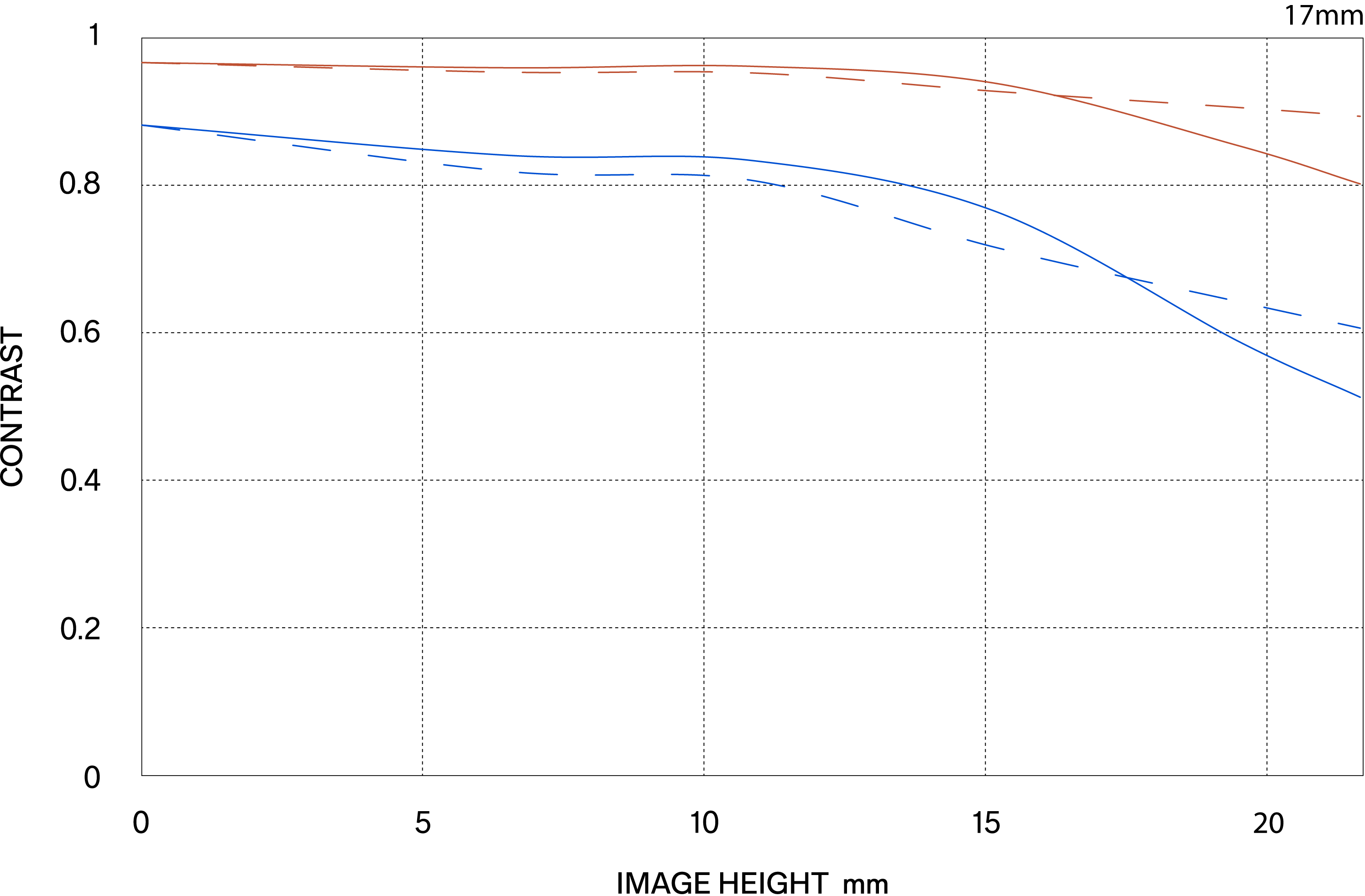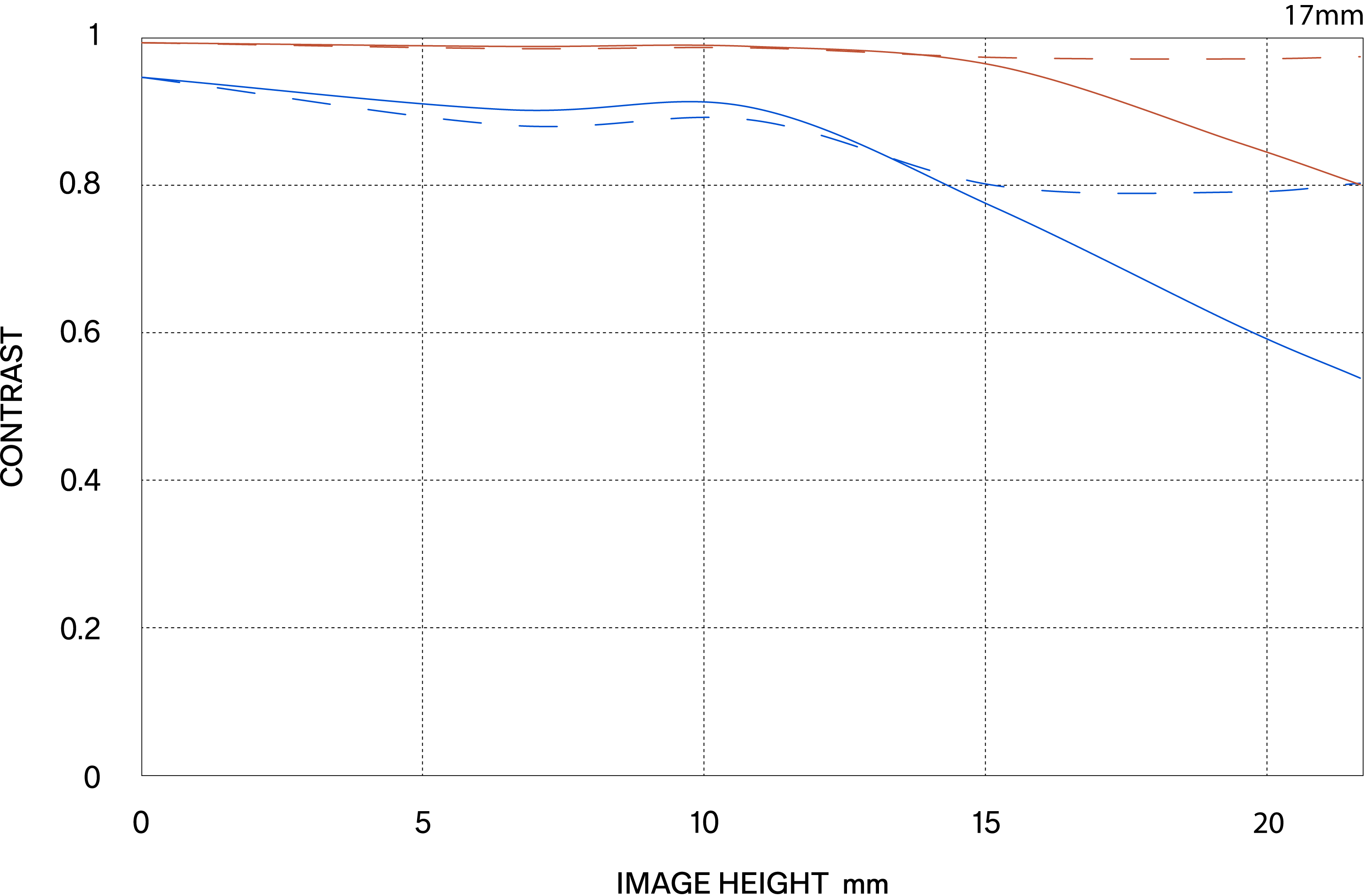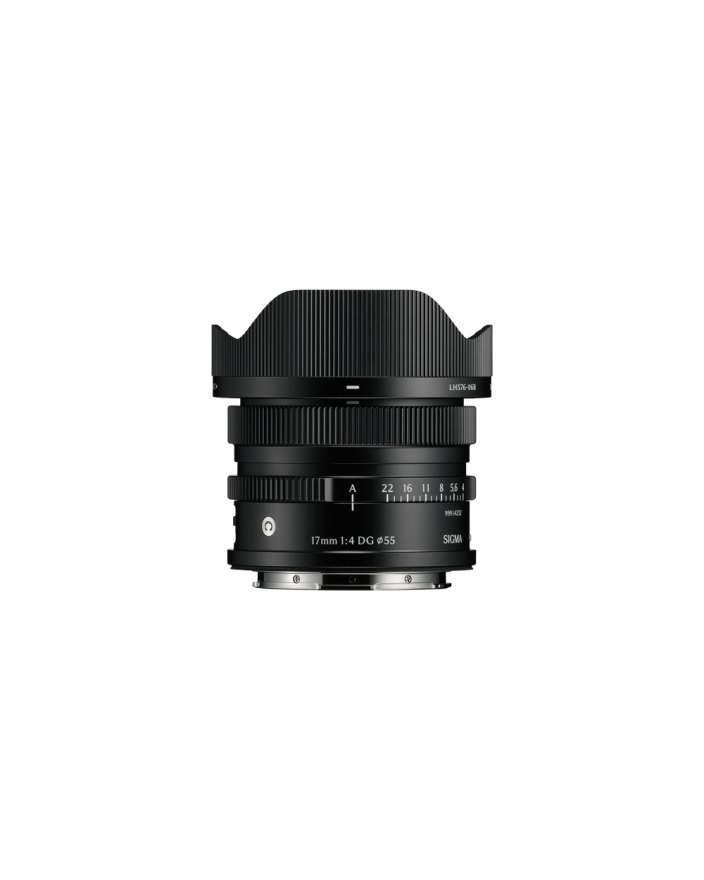CONTEMPORARY17mm F4 DG
- All-metal construction
- Manual aperture ring
- Incredibly compact and lightweight
- Minimum focus distance of only 12cm / 4.8 in.
- Reproduction ratio of 1:3.6 for closeup photography
- High-speed, accurate autofocus
- Magnetic lens cap and metal lens hood
- Mount with dust and splash-resistant structure
- Designed to minimize flare and ghosting

Sony E-Mount: 64mm x 50.8mm / 2.5 in. x 2.0 in.
Sony E-Mount: 220g / 7.8 oz.
"Ultra-wide-angle lens" that matches the optical performance standards set by the SIGMA Contemporary line of lenses.
The lens construction consists of two SLD glass elements and three aspherical lens elements. Aspherical lenses are used for both the front and rear optics. This not only keeps the size of the lens compact but also helps with correcting lens aberrations. As a result, the lens features a 55mm filter thread (which is smaller than comparable lenses of similar focal lengths) which makes it easy to change filters between Sigma I series lenses that share the same filter size.* Its construction also helps minimize flare and ghosting that is commonly found in ultra-wide-angle lenses, creating clear images in any environment. This is a lens with truly modern performance, thanks to the advanced processing and production technologies at Sigma's only production facility in Aizu.
A highlight of using the 17mm is the impressive minimum focusing distance of 12cm. Capture close-up macro style images in remarkable detail with expansive backgrounds. It is also suitable for selfies and vlogging, where items need to be shown at an arms-reach. A quiet, high-speed stepping motor drives the AF delivering fast and accurate results in both stills and video.
*In addition to the 17mm F4 DG | Contemporary, I series lenses with a 55mm filter thread include the 24mm F3.5 DG | Contemporary, 45mm F2.8 DG | Contemporary, and 90mm F2.8 DG | Contemporary (as of February 2025).
Exceptional I series build quality with a compact form-factor
All I series lenses have an all-metal construction. The precision-cut aluminum parts not only give the barrel a sleek, stylish finish, but provide superb durability that improves the quality of the entire product. Metal materials are also used in internal structures that slide with the operation ring for added robustness. These high-precision components crafted with Sigma's cutting-edge metalworking technology are also used in Sigma's Cine Lens line-up for professional cinematographers and provide a tactile, ergonomic feel that make the lens a pleasure to use. What is more with the I series is that this high build quality is condensed into a palm-sized lens body. The Sigma 17mm F4 DG | Contemporary is one of the smallest in the series. Combine with multiple I series lenses to create a remarkably compact shooting system that is lightweight and small in size.
Magnetic metal lens cap
I series lenses are accompanied by a dedicated magnetic metal lens cap, in addition to a normal plastic cap. This dedicated metal cap clips to the front surface of the lens magnetically. It is no exaggeration to say that this meticulously crafted cap represents the finishing touch for the I series.
Magnetic metal lens cap holder (sold separately)
When a cap is removed from the lens it should have a proper place where it can be kept. Using this as a starting point, the CH-11 cap holder using the magnetic force of the dedicated cap was created. With the cap attached to the ring plate, and the plate clipped to a bag or belt, the cap is always within easy reach and is less likely to get lost. Plus, its elegant design is a stylish addition to a photographer's equipment.
LENS CONSTRUCTION


- SLD Glass
- Aspherical Lens
MTF CHART
The MTF (Modulation Transfer Function) is one of the measurements for evaluating a lens' performance, and it shows how faithfully the contrast of the subject can be reproduced on the image plane. The horizontal axis shows the image height (distance from the center of the image in mm) and the vertical axis shows the contrast value (maximum value is 1).
The closer the 10 line pairs/mm curve is to 1, the higher the contrast and clarity of the lens is, and similarly, the closer the 30 line pairs/mm curve is to 1, the better the resolution and sharpness of the lens is.
*The MTF chart depicts the result at the wide-open aperture.
*For mirrorless lenses that support distortion correction, the horizontal axis shows the image height equivalent to when an L-Mount lens is attached to a Sigma L-Mount camera with distortion correction applied. (The effect of distortion correction may differ depending on the mount and camera used.)
*The spatial frequency indicates the variation on the image plane before distortion correction is performed.
Spatial Frequency
S: Sagittal Line
M: Meridional Line
10lp/mm




30lp/mm




DIFFRACTION MTF


GEOMETRICAL MTF


Inner focus system
To increase stability, this lens configuration uses movable internal lens elements that adjust focus without changing the length of the lens barrel.
Compatible with Lens Aberration Correction
Matching the optical characteristics of the lens, this function performs in-camera corrections of peripheral illumination, chromatic aberrations, distortion, and more, to further enhance image quality.
*Function available on supported cameras only. Available corrections or auto correction functionality may vary depending on the camera model.
*On cameras where lens aberration correction is controlled with 'ON' or 'OFF' in the camera menu, please set all aberration correction functions to 'ON' (AUTO).
Super Multi-Layer Coating
Sigma's own Super Multi-Layer Coating suppresses flare and ghosting by preventing reflections with in the lens. All lenses in the current Sigma range feature this original technology. In digital cameras, flare and ghosting may also be caused by reflections between the image sensor and lens surfaces. Here too, Sigma's Super Multi-Layer Coating is highly effective, assuring images of outstanding contrast.
Aperture ring
Aperture ring, designed to help users work intuitively.
Focus Mode Switch
Using this switch, it is possible to switch the focus mode between AF and MF.
Linear focus / Non-linear focus (for L-Mount only)
A focus movement method of interchangeable lenses for mirrorless cameras in relation to the rotational angle of the focus ring during manual focusing. With "non-linear focus" the amount of focal point movement varies depending on the focus ring rotational speed. With linear focus, if the focus ring rotational angle is the same, the amount of focal point movement remains the same regardless of the focus ring rotational speed.
Stepping Motor
The lens is capable of smooth, quiet and high-speed AF made possible by a stepping motor, as well as supports Face/Eye Detection AF and video AF.
Mount with Dust and Splash Resistant Structure
The lens mount incorporates rubber sealing to protect the mount from dust and water drops.
Others
- Rounded diaphragm
- Compatible with high-speed autofocus
- Compatible with AF Assist (Sony E-mount only)
- Compatible with Sigma USB DOCK UD-11 (sold separately / L-Mount only)
- High-precision, durable brass bayonet mount
- Support DMF and AF+MF
- Designed to minimize flare and ghosting
- Every single lens undergoes Sigma's proprietary MTF measuring system
- Magnetic metal lens cap
- "Made in Aizu, Japan" craftsmanship
No gallery photos available for this product.

